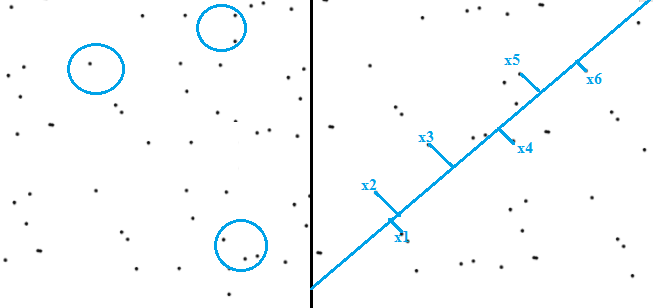What is Distance Sampling?
Distance sampling is a catch-all term to describe a range of methods to estimate the density of biological populations using measured distances to individuals in the population. It can also be used to estimate the abundance of inanimate objects like birds’ nests or animal burrows. This type of sampling — assuming it is properly designed — can improve precision of estimates and reduce bias.
Types of Distance Sampling
The two main methods are line transect and point transect, but other methods (mostly sub-types of either point or line transect) exist.
- Line Transect Surveys
- Cue-Counting
- Point Transect Surveys
- Strip Transects
- Trapping webs
1. Line Transect Surveys:

In traditional sampling, random areas (shown as circles in the left image) are chosen and the number of items are counted. These counts are averaged and used to estimate the population in the whole area. Line transect uses a set of lines; Distances to seen items are noted and used to estimate the population size. The lines are traversed by trained observers on foot, on horseback or on a vehicle. Depending upon the location, boats, scuba gear or aircraft are also used.
2. Cue-Counting:
An offshoot of line transect surveys developed for mapping marine life but extended to other animals. Instead of actual animal sighting, “cues” are counted instead. For example, the blow of a whale or a specific bird song.
3. Point Transect Surveys:
Point transect surveys are similar to line transects. However, instead of a line there is a series of points. The observer usually stays at each point for a set time. For example, there may be 10 equidistant points along the route where the observer stays for 15 minutes at each point.
4. Strip Transects:
Similar to line transects. A strip of width n is chosen and a census is taken of items in that strip. Unlike line transects, distances are not measured. Strip transects have the rather impractical assumption that a count is taken of all items in the strip. It is therefore not used as often as line transects.
5. Trapping Webs:
A sub-type of line transect where traps are placed at intervals along a randomly chosen line. The observed distance in trapping webs is replaced by a known distance of the animal trap.
References:
Buckland et. al. (2001). Introduction To Distance Sampling: Estimating Abundance of Biological Populations 1st Edition..
Stephen T. Buckland, E.A. Rexstad, Tiago A. Marques, C.S. Oedekoven. (2015). Distance Sampling: Methods and Applications.